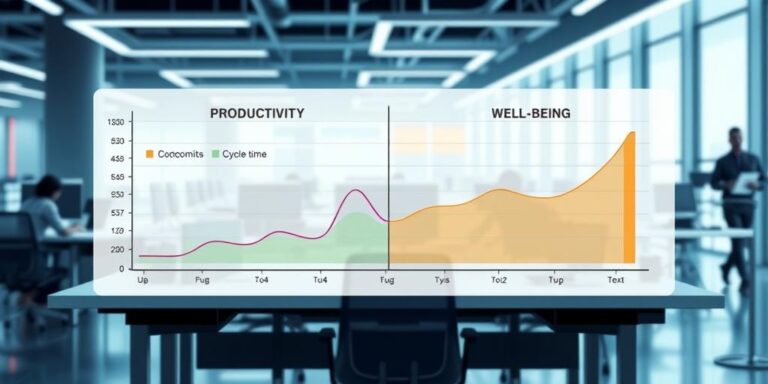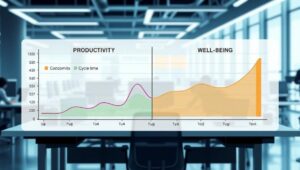Measuring Developer Productivity and Well-being in 2025
As we approach 2025, the software development landscape continues to evolve at a rapid pace. Measuring developer productivity and well-being has become more critical than ever for organizations aiming to optimize their teams and retain top talent. This article explores the key metrics, tools, and strategies that will define how we assess developer performance and overall satisfaction in the coming years.
Key Metrics for Developer Productivity
-
Code Quality:
- Definition: Assessing the maintainability, readability, and reliability of the code produced.
- Measurement: Static code analysis tools, code review processes, and automated testing frameworks.
- Importance: High-quality code reduces technical debt, minimizes bugs, and facilitates easier collaboration among developers.
-
Cycle Time:
- Definition: The time taken to complete a development cycle from the initial commit to deployment.
- Measurement: Project management tools, version control systems, and continuous integration/continuous deployment (CI/CD) pipelines.
- Importance: Shorter cycle times indicate faster delivery of features and improvements, enabling quicker responses to market demands.
-
Deployment Frequency:
- Definition: How often code changes are deployed to production environments.
- Measurement: CI/CD pipelines, release management tools, and monitoring dashboards.
- Importance: Frequent deployments reduce the risk associated with large releases and allow for faster feedback loops.
-
Lead Time for Changes:
- Definition: The time it takes for a code change to go from commit to release.
- Measurement: Version control systems, issue tracking systems, and automated deployment tools.
- Importance: Shorter lead times enable quicker iteration and faster delivery of value to end-users.
-
Throughput:
- Definition: The volume of work completed by a developer or team over a specific period.
- Measurement: Project management tools, issue tracking systems, and velocity tracking.
- Importance: Higher throughput indicates increased efficiency and productivity.
Assessing Developer Well-being
-
Work-Life Balance:
- Definition: The equilibrium between professional responsibilities and personal life.
- Measurement: Surveys, feedback sessions, and monitoring of working hours.
- Importance: A healthy work-life balance reduces burnout, improves morale, and enhances overall productivity.
-
Job Satisfaction:
- Definition: The level of contentment and fulfillment derived from one’s job.
- Measurement: Anonymous surveys, one-on-one meetings, and team retrospectives.
- Importance: Satisfied developers are more engaged, motivated, and likely to remain with the organization.
-
Psychological Safety:
- Definition: The belief that one can speak up without fear of negative consequences.
- Measurement: Team surveys, observation, and feedback mechanisms.
- Importance: Psychological safety fosters open communication, collaboration, and innovation.
-
Opportunities for Growth:
- Definition: The availability of resources and support for professional development.
- Measurement: Training programs, mentorship opportunities, and career advancement pathways.
- Importance: Providing growth opportunities enhances skills, boosts confidence, and increases job satisfaction.
-
Recognition and Appreciation:
- Definition: Acknowledgment of contributions and achievements.
- Measurement: Performance reviews, awards, and public acknowledgment.
- Importance: Recognition boosts morale, reinforces positive behavior, and fosters a culture of appreciation.
Tools and Technologies for Measurement
-
Project Management Tools:
- Examples: Jira, Trello, Asana
- Functionality: Track tasks, manage workflows, and monitor progress.
-
Version Control Systems:
- Examples: Git, GitHub, GitLab
- Functionality: Manage code changes, facilitate collaboration, and track commit history.
-
CI/CD Pipelines:
- Examples: Jenkins, CircleCI, Travis CI
- Functionality: Automate build, test, and deployment processes.
-
Static Code Analysis Tools:
- Examples: SonarQube, ESLint, PMD
- Functionality: Analyze code for defects, vulnerabilities, and adherence to coding standards.
-
Monitoring and Observability Tools:
- Examples: Prometheus, Grafana, Datadog
- Functionality: Monitor system performance, track application metrics, and provide insights into system behavior.
-
Feedback and Survey Tools:
- Examples: SurveyMonkey, Google Forms, Culture Amp
- Functionality: Collect feedback, measure sentiment, and assess employee satisfaction.
Strategies for Improving Developer Productivity and Well-being
-
Foster a Culture of Continuous Improvement:
- Encourage developers to identify and address bottlenecks in their workflow.
- Implement regular retrospectives to review processes and identify areas for improvement.
-
Provide Adequate Training and Resources:
- Ensure developers have access to the tools, training, and documentation they need to perform their jobs effectively.
- Offer opportunities for professional development and skill enhancement.
-
Promote Work-Life Balance:
- Encourage developers to take breaks, disconnect after hours, and prioritize their well-being.
- Offer flexible work arrangements and generous vacation policies.
-
Encourage Collaboration and Communication:
- Foster a culture of open communication and knowledge sharing.
- Implement collaboration tools and practices to facilitate teamwork.
-
Recognize and Reward Achievements:
- Acknowledge and celebrate successes to boost morale and motivation.
- Offer incentives and rewards for outstanding performance.
Conclusion
Measuring developer productivity and well-being in 2025 requires a holistic approach that considers both quantitative metrics and qualitative factors. By leveraging the right tools, implementing effective strategies, and fostering a supportive work environment, organizations can optimize their development teams, retain top talent, and achieve their business goals. As the software development landscape continues to evolve, prioritizing developer productivity and well-being will be essential for success.




